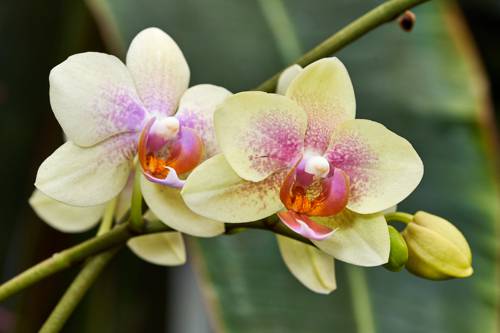
FAQ About Air-Rooted Indoor Plants (Aerial Plants)

What are air-rooted indoor plants?
Air-rooted indoor plants, also known as aerial plants, are species that develop roots above the ground or soil surface. These plants often grow on other surfaces like trees or rocks in their natural habitat. The roots help them anchor and usually absorb moisture and nutrients from the air, rain, or debris around them. Common examples include many orchids, Monstera, and some types of pothos.

How do air roots function in indoor plants?
Air roots in indoor plants serve multiple functions. They help anchor the plant to various structures, such as walls or supports. These roots can also absorb moisture and nutrients directly from the air, which is essential for their survival in their native environments and beneficial indoors when humidity is sufficient.

Why do some indoor plants develop air roots?
Some indoor plants develop air roots due to their natural adaptations. These roots allow plants to anchor themselves to surfaces in their natural habitats, such as tree trunks or rocks, where soil isn't present. Indoors, these adaptations help the plant stabilize and sometimes gather moisture from the air.

How can I care for indoor plants with air roots?
To care for indoor plants with air roots, maintain adequate humidity levels and provide a stable structure for support. A humidity level above 50% is often beneficial. Support can be a trellis, moss pole, or another plant-safe structure. Regularly misting the air roots can help, but be sure not to overwater the main plant.

What humidity levels are best for air-rooted indoor plants?
Air-rooted indoor plants generally thrive in higher humidity, typically over 50%. You can achieve this by using a humidifier, placing a water tray near the plant, or frequent misting. Be mindful of mold development and ensure adequate ventilation.

Do air-rooted plants require special soil conditions?
While air-rooted plants can grow in soil, it should facilitate good drainage and aeration. A mix of orchid bark, perlite, and peat can be ideal, depending on the specific plant's needs. Always check the particular requirements of each species to ensure optimal soil conditions.

How should I water air-rooted indoor plants?
Watering should be minimal for air roots, focusing instead on maintaining humidity. For the plant itself, follow its typical watering requirements, ensuring the soil is slightly dry between waterings. Misting the air roots occasionally can supplement humidity.

What support structures are ideal for air-rooted indoor plants?
Ideal support structures for air-rooted indoor plants include moss poles, trellises, and lattices. These should mimic the natural environment and offer stability for anchoring roots. Choose materials that won't rot quickly and are safe for the plant.

Can I prune the air roots of indoor plants?
Pruning air roots should be done cautiously. While trimming a few long roots won't harm most plants, it's generally advised to leave them unless they're causing issues, like interference with furniture or other plants. Always use clean, sharp tools to avoid plant damage.

Do all indoor plants develop air roots?
Not all indoor plants develop air roots. Air roots are typical in certain species adapted to environments where they anchor and get nutrients from the air. Species like Monstera, Philodendron, and some orchids commonly exhibit air roots.

How do I increase humidity for air-rooted plants indoors?
To increase humidity for air-rooted plants, use a humidifier in the room, place water trays near the plant, mist the plant with water, or group plants together to create a microclimate. Ensure proper ventilation to prevent mold and mildew growth.

Why are my air roots drying out?
Air roots might dry out due to low humidity, excessive air movement, or lack of hydration. Ensure the plant is kept in an appropriately humid environment and mist the air roots regularly to prevent them from drying. Check for drafts which can dehydrate the plant.

Can air roots absorb nutrients?
Yes, air roots can absorb nutrients, particularly in environments with high humidity and when the roots are misted with nutrient-rich solutions or rainwater that carries natural nourishment. This capability is one reason these roots serve the plant so well in natural habitats.

Are air roots the same as aerial roots?
Yes, air roots are often referred to as aerial roots. The terms are used interchangeably to describe roots that grow above the ground, typically on or above the plant or another surface, and have functions of anchoring and moisture/nutrient absorption.

Is it possible to propagate plants using air roots?
Propagation through air roots depends on the plant species. Some plants, like Monstera, can be propagated by cutting a section with air roots and planting it in an appropriate medium. It's crucial to ensure the cuttings have at least one node and air root for successful propagation.

Do air roots need sunlight?
Air roots themselves do not need direct sunlight, but they benefit from adequate light for the overall plant health. Ensure the entire plant receives the appropriate light levels for its species, as this supports both normal root and aerial root development.

Can I support air-rooted plants with wire?
While wire can be used to support air-rooted plants, it should be coated to prevent plant damage and embedded gently without constricting the growth. A better option is using natural fibers or plant-safe ties that allow flexibility as the plant grows.

Should I fertilize air-rooted plants differently?
Fertilizing air-rooted plants follows the same general guidelines as for terrestrial plants. Use a balanced, water-soluble fertilizer suitable for the specific species, applied as per the plant’s nutrient requirements. Foliar feeding via mist spray can also help with nutrient absorption through the air roots.

What are some common problems with air-rooted plants?
Common problems with air-rooted plants include root rot due to overwatering, insufficient humidity leading to dried-out air roots, and inadequate support causing poor anchorage. To prevent these, ensure balanced watering, maintain proper humidity, and provide appropriate support structures.

Do air roots harm the plant if unmanaged?
Air roots are generally not harmful when left unmanaged. They are a natural part of the plant's growth and assist in anchorage and nutrient absorption. However, if they become too long or invasive, they can interfere with nearby objects or other plants and may need gentle management.
